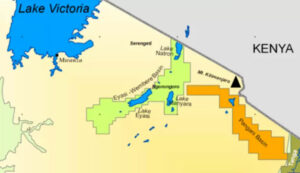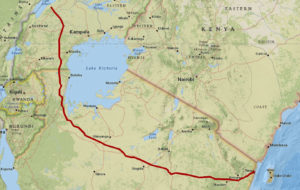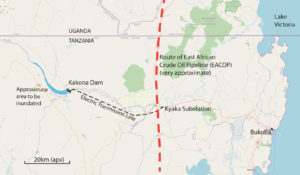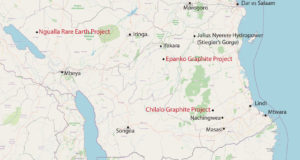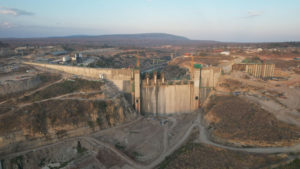by Ben Taylor

Images from the “National Clean Cooking Strategy (2024-2034)” publication showing cooking on electric and gas as a cleaner alternative to charcoal.

Images from the “National Clean Cooking Strategy (2024-2034)” publication showing cooking on electric and gas as a cleaner alternative to charcoal.
Africa Energy Summit 2025
The Africa Energy Summit, held in January 2025 in Dar es Salaam, marked a pivotal moment for African energy policy and regional cooperation. Hosted by the Government of Tanzania, together with the African Union, the African Development Bank (AfDB), and the World Bank, the summit reportedly convened over 25 African Heads of State, 1,000 delegates, and global partners to address the continent’s energy crisis. Nearly 600 million people across the continent lack reliable electricity according to the International Energy Agency (IEA). The event was themed around the “Mission 300 initiative” – an aim to connect 300 million Africans to electricity by 2030.
The summit reinforced Tanzania’s growing stature as a regional leader in East Africa’s energy landscape. President Samia Suluhu Hassan’s hosting of the event signalled Tanzania’s commitment to spearheading energy transformation, bolstered by the near-completion of the Julius Nyerere Hydropower Project (JNHPP), which has added 2,115 megawatts to the national grid (see below). The summit’s attendance was impressive, including heads of state from Nigeria, Kenya, Zambia and others, as well as key figures like UN Deputy Secretary-General Amina Mohammed, World Bank President Ajay Banga, and African Development Bank President Dr. Akinwumi Adesina. This has been reported as representing a unified African push for energy access, fostering pan-African solidarity.
The summit’s main outcomes included the Dar es Salaam Energy Declaration and the unveiling of National Energy Compacts by 12 countries, including Tanzania, Nigeria, and Senegal. The Declaration outlined actionable reforms including:
Commitment to Universal Energy Access: The Declaration prioritises providing reliable and affordable electricity to 300 million Africans by 2030, aligning with Sustainable Development Goal 7 and the African Union’s Agenda 2063. It emphasises inclusive access, particularly for rural and underserved communities.
Promotion of Renewable Energy: It underscores a shift toward renewable energy sources—such as solar, hydroelectric, and geothermal—to reduce reliance on fossil fuels like firewood and charcoal. This focus supports climate resilience and aligns with the Paris Agreement, aiming to integrate clean energy solutions into national grids and promote sustainable development.
Support for National Energy Compacts: The Declaration endorses country-specific National Energy Compacts from 12 nations (including Tanzania, Nigeria, and Zambia), which outline tailored plans to expand electrification, reform energy sectors, and enhance regional grid integration through initiatives like the East African Power Pool.
Mobilization of Financial Resources: It secures over $40 billion in pledges from the African Development Bank, World Bank, and other partners, alongside a $5 billion Mission 300 Guarantee Facility to de-risk private sector investments, fostering public-private partnerships to scale up energy infrastructure.
Advancement of Clean Cooking Solutions: The Declaration commits to expanding access to clean cooking technologies, such as natural gas and improved cookstoves, to reduce health risks from traditional biomass use and support environmental sustainability across African households.
Tanzania’s national compact set ambitious targets: electrifying 8.3 million households and 64,359 villages by 2030, raising the national electrification rate from 46% to 75%, and expanding cross-border electricity trade through the East African Power Pool.
The summit’s success lies in its political will and financial commitments, but its diplomatic test will be sustaining global partnerships while navigating Africa’s debt burdens. By prioritising African-led solutions and climate-resilient infrastructure, the event positions the continent as a proactive player in the global energy transition, potentially redefining its role from resource-rich-but-cash-poor to an aspiring clean energy powerhouse.
Stiegler’s Gorge Dam reaches full turbine capacity
A significant milestone has been achieved at the Julius Nyerere Hydropower Project (JNHPP), located at Stiegler’s Gorge on the Rufuji river, as all nine turbines are now fully operational, according to the Deputy Prime Minister and Minister of Energy, Dr Doto Biteko. They are collectively generating 2,115MW.
“It is a great joy that all the machines are operational and generating power. The dream of harnessing electricity from this dam has come true, and power is now available,” said Dr Biteko. He added that arrangements are afoot to invite President Samia Suluhu Hassan for the official project inauguration. Further, Egypt has confirmed its head of state will attend the inauguration, with the event schedule being finalised.
With the nation’s power production capacity increased, the government is in final discussions with Zambia to begin exporting electricity. A transmission line is currently under construction, with Zambia also building its section, paving the way for energy trade between the two nations.
A $320 million project to connect Zambia and Tanzania’s power supplies is being financed largely by the World Bank, with support from the European Union and the UK.
Dr Biteko added that the government is also focusing on expanding electricity transmission infrastructure within the country so as to benefit more people.
Tanzania issues helium mining licence
Tanzania has made a significant step towards helium production, with the issuance of the country’s first-ever helium mining licence to Helium One Global. The licence was granted for the company’s Rukwa Helium Project, which spans 480 square kilometres across the Momba and Sumbawanga districts in southern Tanzania’s Rukwa region.
In September 2024, Helium One Global had announced significant progress in its southern Rukwa operations and submitted a comprehensive Mining Licence (ML) application for its helium project. This was supported by an in-depth feasibility study, including subsurface modelling and a detailed commercial development plan.
The global helium sector is critical to industries like healthcare, electronics, and aerospace, driven by helium’s unique properties as a non-reactive, low-density gas essential for MRI scanners, semiconductor manufacturing, and scientific research. Global demand is rising, with the market projected to grow from $2.7 billion in 2022 to over $4 billion by 2030, fuelled by technological advancements and limited supply. Major producers like the United States, Qatar, and Russia dominate, but supply constraints and geopolitical tensions have spurred exploration in new regions like Tanzania.
The Rukwa Basin holds the world’s largest known primary helium deposit (138 billion cubic feet), positioning the country as a potential game-changer. Companies like Helium One Global and Noble Helium are leveraging advanced exploration techniques to tap these reserves, aiming to diversify the global supply chain amid increasing prices and demand.
The announcement of Tanzania’s first helium mining licence has had an immediate impact on Helium One Global’s market performance. The company, which is listed on the London Stock Exchange, saw its stock price rise by 17% following the news.
Helium One Global’s CEO, Lorna Blaisse, expressed her enthusiasm about the development, emphasizing the strategic significance of Tanzania’s helium reserves.
“This marks a milestone for both the Company and Tanzania, as it is the first mining license to be offered for helium in the country and of such a significant size,” she said. “We very much look forward to progressing the project in Tanzania through to production, as well as remaining opportunistic on further opportunities in-country and elsewhere.” Assistant Commissioner Francis Mihayo from Tanzania’s Ministry of Minerals remarked, “The positive results from the Helium One Global’s exploration deepen hope for helium presence in Tanzania.”

